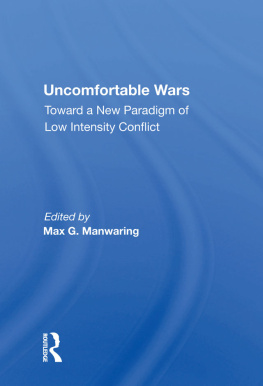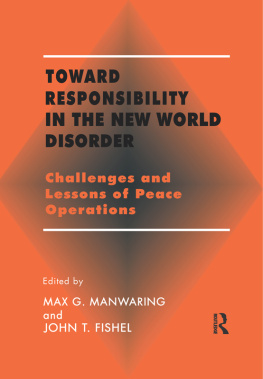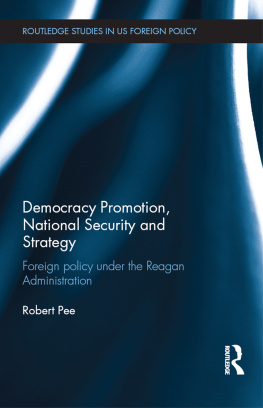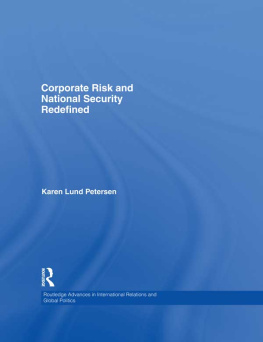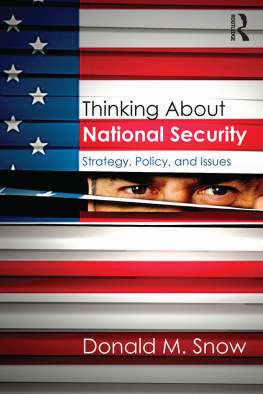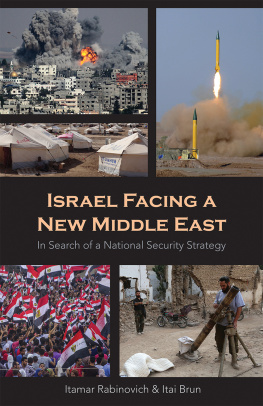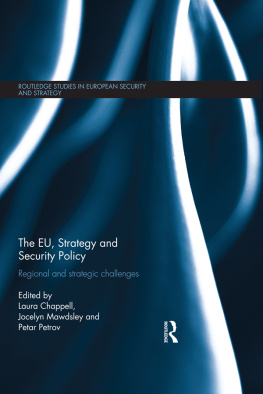Cover
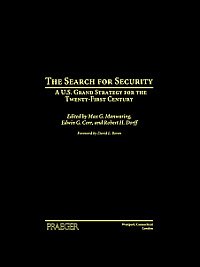
| title | : | The Search for Security : A U.S. Grand Strategy for the Twenty-first Century |
| author | : | Manwaring, Max G.; Corr, Edwin G.; Dorff, Robert H. |
| publisher | : | Greenwood Publishing Group |
| isbn10 | asin | : | 0275968634 |
| print isbn13 | : | 9780275968632 |
| ebook isbn13 | : | 9780313048128 |
| language | : | English |
| subject | United States--Military policy, Strategy, National security--United States, World politics--21st century. |
| publication date | : | 2003 |
| lcc | : | UA23.S39 2003eb |
| ddc | : | 355/.033573 |
| subject | : | United States--Military policy, Strategy, National security--United States, World politics--21st century. |
Page i
THE SEARCH FOR SECURITY
Page ii
This page intentionally left blank.
Page iii
THE SEARCH FOR SECURITY
A U.S. GRAND STRATEGY FOR THE TWENTY-FIRST CENTURY
Edited by Max G.Manwaring,Edwin G.Corr, and Robert H.Dorff
Foreword by David L.Boren

Page iv
Library of Congress Cataloging-in-Publication Data
The search for security: a U.S. grand strategy for the twenty-first century/edited by Max G.
Manwaring, Edwin G.Corr, and Robert H.Dorff; foreword by David L.Boren.
p. cm.
Includes bibliographical references and index.
ISBN 0-275-96863-4 (alk. paper)
1. United StatesMilitary policy. 2. Strategy. 3. National securityUnited States. 4.
World politics21st century. I. Manwaring, Max G. II. Corr, Edwin G. III. Dorff,
Robert H., 1951
UA23.S39 2003
355.033573dc21 2002029774
British Library Cataloguing in Publication Data is available.
Copyright 2003 by Max G.Manwaring, Edwin G.Corr, and Robert H.Dorff
All rights reserved. No portion of this book may be
reproduced, by any process or technique, without the
express written consent of the publisher.
Library of Congress Catalog Card Number: 2002029774
ISBN: 0-275-96863-4
First published in 2003
Praeger Publishers, 88 Post Road West, Westport, CT 06881
An imprint of Greenwood Publishing Group, Inc.
www.praeger.com
Printed in the United States of America

The paper used in this book complies with the
Permanent Paper Standard issued by the National
Information Standards Organization (Z39.481984).
10 9 8 7 6 5 4 3 2 1
Page v
CONTENTS
Foreword by David L.Boren | vii |
Preface | xi |
Part IThe Global Security Environment at the Beginning of the Twenty-First Century |
| Vague Threats and Concrete Dangers: The Global Security Environment at the Start of the Twenty-First Century
Richard L.Millett | |
| The Current U.S. National Security Strategy and Policy: A Brief Appraisal
Robert H.Dorff | |
Part IIToward a Forward National Security Strategy |
| Managing Globalization: Lessons for Constructing a Strategic Bridge to the Future
Max G.Manwaring | |
| The Central Political Challenge in the Global Security Environment: Governance and Legitimacy
Edwin G.Corr and Max G.Manwaring | |
| The Major Economic Challenge in the Global Security Environment: Competing in an Interdependent World
Leif Rosenberger | |
Page vi
| The Information Challenge in the Global Security Environment
Dennis M.Rempe | |
| The Challenge of Deterrence in the Global Security Arena: Thinking about a Peaceful and Prosperous Tomorrow
Edwin G.Corr and Max G.Manwaring | |
Part IIIWhere to from Here? |
| A Grand Strategy for the United States at the Start of the New Millennium: The Broad Outlines
Edwin G.Corr and Max G.Manwaring | |
| Strategy, Grand Strategy, and the Search for Security
Robert H.Dorff | |
Index | |
About the Contributors | |
Page vii
FOREWORD
David L.Boren
Protecting the nations security, its people, its territory, its interests at home and abroad, and its values and way of life is the American governments most enduring goal and constitutional duty. In the years since the demise of the Soviet Union and the end of the Cold War, however, I have watched Republican and Democratic administrations zigzag to adjust the direction of foreign and security policy in a fog of uncertainty and inconsistent purpose. The results have left much to be desired.
Uncertain about the nature of a hazy new world situation and what to do with regard to it, American leadership simply reacted to TV images and weekly polls. The temptation was to forsake a guiding strategic vision and make short-term decisions for temporary domestic political gain. In that context national security strategy was more a sound-bite list of aspirations and list of self-proclaimed accomplishments than hard-nosed ends, ways, and means designed to create and sustain security, stability, socioeconomic development, legitimate governance and civil societies, and peace in the global community.
In this situation many decisionmakers and policymakers have been constantly surprised at the chaos and violence emerging out of deeply divided societies. They have also been confused and unable to decide what to do or how to do it beyond the usual crisis management and spin control. Rwanda and Burundi provide good examples. Warning signals regarding the potential for major violence between Hutus and Tutsi between and within those two countries have been relatively consistent since the two countries gained their independence in 1962. Rwanda exploded in 1963. Massacres took place in Burundi in 1965, 1966, and 1969. In 1972 and 1973 over 100,000 Hutus reportedly were killed. In 1988 about 20,000 more Hutu were considered victims of genocide. A new wave of violence erupted again in 1993 and 1994 reportedly leaving more than 500,000 dead. The situation in large parts of Africa is still one of disorder and decay. As another example, government-supported thugs are reportedly turning the prosperous country
Next page

